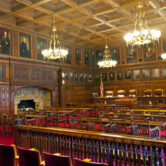(CN) — Leading experts in virology and pathogen transmission say public health departments should craft robust regulations for building ventilation, a move that could protect millions from deadly viruses and pollutants.
Research during the novel coronavirus pandemic has shown that community transmission events occurred after large numbers of people gathered in poorly ventilated indoor settings with individuals infected with Covid-19.
That research also indicated the threat of rapid spread of aerosolized, infective virus particles outdoors and increased risk of virus transmission in enclosed settings.
Scientists wrote in the study published Thursday in the journal Science that air quality control in buildings has been essentially neglected compared with things like sanitation and food safety regulations but is just as vital for public health.
"Such airborne transmission is potentially the dominant mode of transmission of numerous respiratory infections,” the study said. “We also have strong evidence on disease transmission, for example in restaurants, ships, and schools, suggesting that the way we design, operate, and maintain buildings influences transmission."
Current ventilation guidelines tend to focus on maintaining indoor climate levels, reducing odors and pushing carbon dioxide out of buildings. Few regulations provide a framework for controlling the spread of pathogens, the study said.
But a mandate from the World Health Organization and individual nations’ public health officers could lead to implementation of strong ventilation standards.
"None of this means that every indoor space should become a biosafety facility,” the scientists wrote. “It means that a building should be designed and operated according to its purpose and the activities conducted there, so that airborne infection risk is maintained below an acceptable level."
The risk of infection from aerosolized virus particles indoors is significantly reduced or virtually eliminated through high ventilation combined with air disinfection and air filtration systems, the scientists said.
Researcher Trish Greenhalgh of the University of Oxford said in a statement released with the study nothing less than a “paradigm shift” is needed to revamp the world’s approach to ventilation standards.
“Up to now, most of the efforts to prevent transmission of Covid-19 and other airborne respiratory diseases such as tuberculosis has focused on influencing individual behaviour such as mask-wearing, cough hygiene and handwashing,” Greenhalgh said. “These measures are still important, but they will be relatively ineffective in the indoor environment until we ensure that the air we inhale contains far fewer particles that have been exhaled by others in the room. We need to rethink the practice, currently common in many countries, of keeping windows closed and recycling stale air in air conditioning.”
Greenhalgh suggested households and building operators encourage open windows, drafty rooms and disinfecting any recycled air.
Researchers found very few examples of engineering-based interventions in public buildings and transportation infrastructure designed to stem community transmission of Covid-19.
“A paradigm shift is needed on the scale that occurred when Chadwick's Sanitary Report in 1842 led the British government to encourage cities to organize clean water supplies and centralized sewage systems,” researchers wrote. “"In the 21st century we need to establish the foundations to ensure that the air in our buildings is clean with a significantly reduced pathogen count, contributing to the building occupants' health, just as we expect for the water coming out of our taps."
University of Leeds researcher Cath Noakes said in the statement the Covid-19 pandemic exposed gaps in air quality safety regulations.
“Over the years, we have neglected the role that the air circulating inside a building plays in the way germs and viruses may spread between people,” Noakes said. “The pandemic has exposed that deficiency in our understanding and the way we seek to make buildings safer to use.”
The scientists said improved ventilation in buildings could improve the well-being and “performance” of those inside, along with reducing exposure to viruses and air pollution.
"We need to introduce new mechanisms that keep pathogen levels in the air flow in buildings and other enclosed spaces to a minimum,” Noakes said in the statement. “That approach can be achieved with technology backed-up with a requirement to meet new standards."
Noakes is a professor of environmental engineering for buildings and a member of SAGE, a body that advises the United Kingdom on sciences-based emergencies.
Researchers did not respond to a request for further comment on the study by press time.
Subscribe to Closing Arguments
Sign up for new weekly newsletter Closing Arguments to get the latest about ongoing trials, major litigation and hot cases and rulings in courthouses around the U.S. and the world.









